SciTech-Mathmatics-Probability+Statistics:Quantifing Uncertainty_统计数据分析:朱怀球PKU-3-Sampling Theory 统计抽样理论基础
Statistics & Data Analysis
— Zhu Huaiqiu, Peking University
《统计与数据分析》, 朱怀球, 北京大学
7 Steps
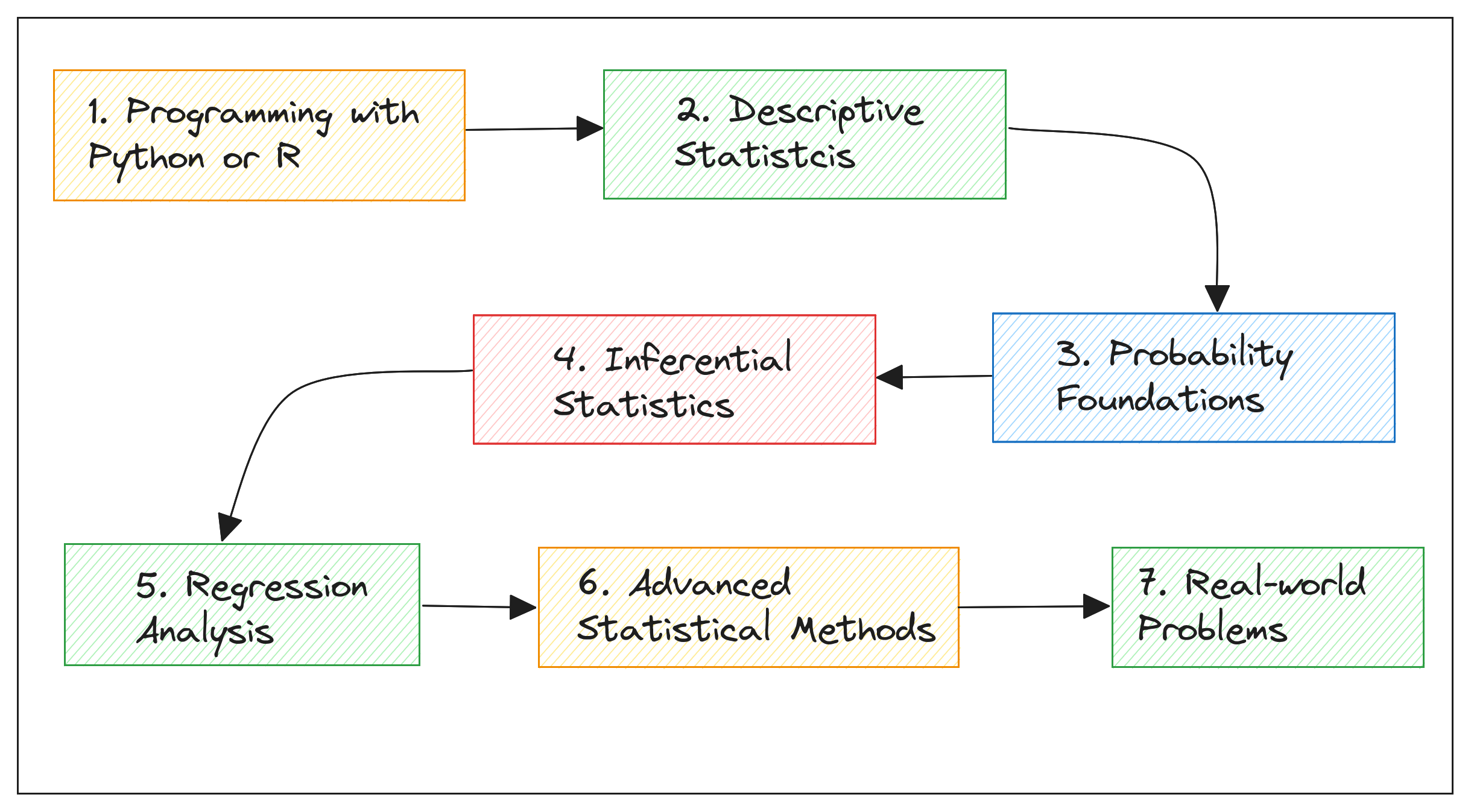
§3 统计抽样理论基础
"\(\large \text{ Get your facts first, then you can distort them as you please.}\)"
— \(\large Mark\ Twin\)
"\(\large \text{ Our behavior, attitudes, and sometimes actions are based on samples.}\)"
— \(\large Elements\ of\ Sampling\ Theory\ and\ Methods\)
3.1 统计抽样的基本概念
\bm{ Statistical\ Inference }\ Theory \begin{cases} \bm{ Hypothesis\ Testing }\ Theory \\
\bm{ Parameter\ Estimation } \ Theory \\ \bm{ Statistical\ Sampling }\ Theory \\ \bm{ Probability\ }\ Theory \\
\end{cases} \\
\end{array} \]
Comparing: Statistics 和 Probability

Statistics基本思想( 总体 — 样本 — 总体 )
\(\large \begin{array}{rl} \\
X :& \bm{ Population },\ Statistics: \mu,\ \tau, \sigma, \ \sigma^2 \\
\Theta :& \bm{ Parameter\ Space } \\
\theta :& \bm{ Parameter } \\
\{X_i\}:& \bm{Sample} ,\ Statistics: \overset{-}{x}, \ \\
\overset{\sim}{\Theta}:& \bm{ Parameter\ Estimation } \\
\end{array}\)
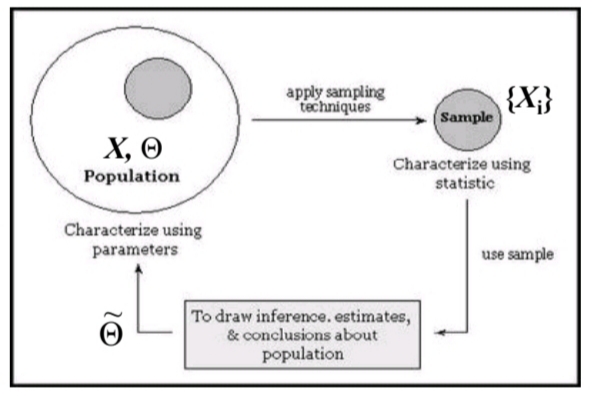
Sampling Concept(抽样 的 概念)
For \(\large \text{ one existing }\) \(\large \bm{Measuring\ Population }\) (named \(\large \bm{\text{Simple Population}}\)),
sample \(\large \bm{Measuring\ Sample}\) (named \(\large \bm{\text{Simple Sample}}\) ) from the \(\large \bm{\text{Simple Population}}\)), using specific sort of \(\large \bm{\text{Inference Method}}\).
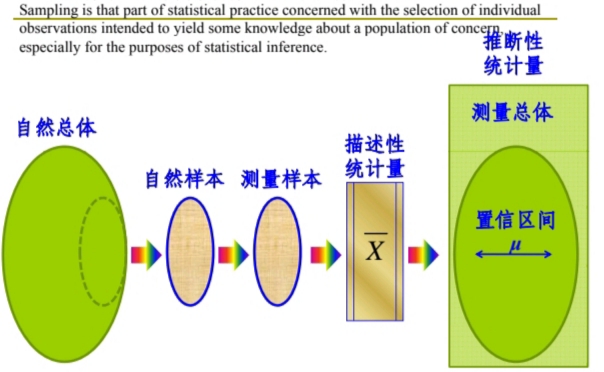
\(\large \begin{array} {lll} \\
\bm{ Population(Natural) } &\Rightarrow \bm{ Sample(Natural) } &\Rightarrow \bm{ Sample(Measuring) } \\
\bm{ Sample(Measuring) } &\Rightarrow \bm{ Descriptive\ Statistics } &\Rightarrow \bm{ Population(Measuring) } \end{array}\)
Sampling & Statistics
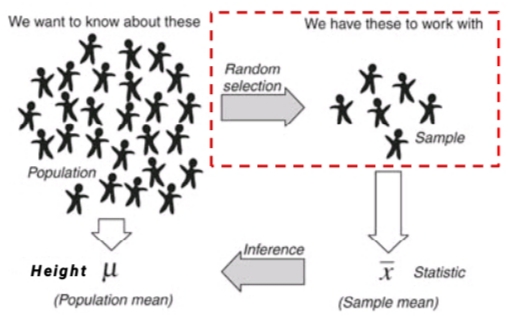
Parameters & Statistics
Parameters(of Population) and Statistics(of Sample)
\bm{ Statistical\ Theory } & \begin{cases} \bm{ Center\ Tendency } & \rightarrow \bm {Mean} \\
\bm{ Variation\ Tendency } & \rightarrow \bm {Variance, \ STD} \\
\end{cases} \\
\bm{ Probability\ Theory } & \begin{cases} \bm{ Center\ Tendency } & \rightarrow \bm {Expectation} \\
\bm{ Variation\ Tendency } & \rightarrow \bm {Variance} \\
\end{cases} \\
\end{array} \]
1.4.1 Statistics(统计变量) 和 Observation(观测) of Statistical Resources(统计资料)
Statistics(统计变量):
研究对象的、可测量的特征
且对于一组对象中的不同对象可以取不同的值。Observation Value(观测值): 变量的每一个测量值(x,x)
- Quanlitative Variable(定性变量): Non-Rankable观测值, 特征的 量值不能排序
- Quantitative Variable(定量变量): Rankable 观测值, 特征的 数量可以排序
- Discrete Variable
- Continuous Variable
Statistical Function:
- 函数关系,运用统计方法确定的,自变量和因变量之间的,
- 只需要定义域、值域和两个变量间的对应关系,
并不总是需要等式表达式
Statistical Resources(统计资料):
观测结果组成的集合
- 定性统计资料、定量统计资料
- 连续统计资料、离散统计资料
- 有效数字: 在观测尺度(或科学计算)中实际能够得到的所有数字
常见问题:- \(\large 102个细胞\)
- \(\large 10,100个细菌(精确到100) \ \rightarrow\ 10,050 \text{ ~ } 10,150\)
- \(\large 23.4\%(23.437201\%?)\)
- \(\large 4.15 \text{ ~ } 4.25\ \times\ 10^{-3}\)
Observation of Statistics(统计变量的观测)
统计资料测量值, 受各种随机因秦的影响
System Error(系统误差)
System Error(系统误差)的大小,
- 稳定(观测过程不变),
- 可预测(用计算或实验方法可求得),
- 可补偿(可修正或调整使其减少).
Random Error(随机误差):
在相同条件下, 对同一Statistic的多次观测,
由于各种 Random Factors, 会出现测量值时而偏大、时而偏小的误差现象, 这种类型的误差叫Random Error。
在确定的测量条件, 对同一Statistic多次测量并用它的算术平均值, 作为它的测量结果, 能够比较好地减少Random Error。Statistical Rules of Random Error
- 绝对值相等的 正的与负的 误差 出现的机会相同
- Variance: 绝对值小的误差 比 绝对值大的误差 出现的机会多
- Range: 误差 不会超出 一定的范围。
Descriptive Statistics(of Samples)
\text {Samples Data} \begin{cases} \\
\bm{ Center\ Tendency } \overset{ \bm {Mean} }{ \rightarrow } & \begin{cases}
& \bm{ Mean } \\ & \bm{ Median } \\ & \bm{ Mode } \\
\end{cases} \\
\bm{ Variation\ Tendency } & \begin{cases}
& \overset{ \bm{Range} }{ \rightarrow } & \begin{cases}
\bm{ Max } \\ \bm{ Min } \\
\end{cases} \\
& \overset{ \bm{Quartiles} }{ \rightarrow } & \begin{cases}
\bm{ Up Quartile } \\ \bm{ Down Quartile } \\
\end{cases} \\
\end{cases} \\
\end{cases} \\
\end{array} \]
Population Parameters
设总体 \(\large X\) 容量为 \(\large N\), 个体取值为\(\large \{x _i \},\ i \in [1, N]\), 定义:
\(\large \begin{array}{ll} \\
\text{ population }mean : & \mu = \dfrac{1}{N} \overset{N}{\underset{i =1}{\sum}}{ x_i } \\
\text{ population }total : & \tau = \dfrac{1}{N} \overset{N}{\underset{i =1}{\sum}}{ x_i } = N \cdot \mu \\
\text{ population }variance : & \sigma^2 = \dfrac{1}{N} \overset{N}{\underset{i =1}{\sum}}{ (x_i - \mu)^2 } \\
\text{ population }standard\ deviation : & s = \sqrt{ \sigma^2 } \\
\end{array}\)
3.1.1 Statistical Model and Statistical Sampling Model
- Statistical Model:
- 设 \(\large \{\Omega, F_{\Omega}\} \ 为可定义\ p.\ f.\ 的\ Measurable\ Space\),
- \(\large \Omega\ is \text{ Sample Space }\)
- \(\large F_{\Omega}\ is \text{ p. f.(Probability Function) }\)
$\large \text{ for measuring the } \bm{Likelyhood} \text{ of the each } \bm{Outcome} $
- \(\large \Phi \text{ 为其上的一个} \bm{ Distribution\ Cluster(概率分布族) }\),
- 设 \(\large \{\Omega, F_{\Omega}\} \ 为可定义\ p.\ f.\ 的\ Measurable\ Space\),
\(\large 则三元组\{\Omega, F_{\Omega}, \Phi \}为\bm{ Statistical\ Model },\ 按是否取决于参数变量分两类\)
- \(\large \bm{ 参数统计模型 }:若 \bm{ 概率分布族 \Phi } \text{ 取决于某一} \ \bm{ \theta(Parameter\ Variable) }\)
$\large \Phi =\{ P(\theta) | \theta \in \Theta,\ where\ \Theta \text{ is the }\ \bm{ Parameter\ Space }\} $ - \(\large \bm{ 非参数统计模型 }:\ \bm{ 概率分布族 \Phi } \text{ 不取决于任何} \ \bm{Parameter\ Variable}\)
- 乘积模型 和 重复抽样模型
\(\large 设\ \{\Omega, F_{\Omega}, \Phi \}\ 和 \ \{\Omega', F_{\Omega}', \Phi' \}\ 为两个\ Statistical\ Model\),
$\large 则\bm{ 乘积模型 } \{ \Omega \bigotimes \Omega', F_{\Omega} \bigotimes F_{\Omega}', \Phi \bigotimes \Phi' \} 记作 \{ \Omega, F_{\Omega}, \Phi \} \bigotimes \{\Omega', F_{\Omega}', \Phi' \} \ $- $\large n\ 个\bm{等同}的\ \{\Omega, F_{\Omega}, \Phi \}\ 的\bm{乘积模型}称 \bm{ 重复抽样模型 },记为\{ \Omega, F_{\Omega}, \Phi \}^n $
- \(\large \bm{乘积模型} \text{ 实际等于 }\bm{独立观察系统}\)
- $\large \bm{重复抽样模型} \text{ 等于 }\bm{对一个观测对象} \text{ 进行 }\bm{有限次独立抽样结果} \text{ 的 }\bm{描述} $。
3.1.2 Sampling Design
\(\large \text{ Results from } \bm{probability\ theory} \text{ and } \bm{statistical\ theory} \text{ are } ,\)
\(\large employed\ to\ \bm{guide\ practice\ of\ sampling}.\)
\(\large Random\ Sampling\)(随机抽样, 简称抽样):
\(\large \text{ for } \bm{observing\ the\ elements\ of\ Population\ X },\)
\(\large 由其 \text{ 按照 } \bm{一定的概率} 抽取 \bm{\ Some\ Individuals}\).
\(\large Random\ Sample\)(随机样本, 简称样本):
\(\large 按照\bm{一定的概率}由Population \ \bm{X} =\{ x_i \},\ i \in [1, N] 抽取\bm{作为总体代表}\ 的\)
\(\large \bm{\ Some\ Individuals\ 的集合} \ \\{ X_1, X_2, \dots , X_n \\},\ n<N,\)
\(\large\ 称为\ \bm{ 容量为\ n\ 的Sample\ X} \ \\{ X_i \\}, \ i \in [1, n]\)
讨论
- 构成某一样本的每一个体都必须取自某一特定的统计总体,
不允许该总体之外的个体计入该总体的样本; - 样本个体的抽取应是按一定的概率进行的,而具体样本的产生应是随机的,
因此必须排除 人的主观因素 对 样本个体、抽取 和 样本生成 的干扰; - Sample是Population的代表,带有其 Distribution 信息;
- 因而, 能够 推断Population的Distribution规律;
- 然而,Sample只是Population的一个subset, 有随机性;
因此,由Sample推断Population, 会产生 代表性误差。
\(\large Random\ Sampling\)的优点
\(\large Random\ Sampling\)是按照 Probability 来进行的,
即 Population 的任一 Individual 都按照 某一特定的Probability 有可能被选择,
产生的 Sample 的组成 因此是 随机的。
- 客观: 可避免抽样者有意或无意的偏好;
- 经济: 以尽可能小容量的Sample 来实现对Population 尽可能客观的Statistical Inference;
- 容差: 可较好地估计出由Sampling Method带来的Error;
- 可控: 可根据对Sampling Error的要求来设计Sample Size。
- 工业化革命的直接产物: 大规模制造要求标准化设计和制造,
对制造过程的质量控制, 直接诞生了统计抽样思想和技术.
根据 Statistics of Samples 对 Parameters of Population 进行 Estimation估计
\(\large \begin{array}{ll} \\
\text{ based on Statics of Samples estimate Parameters of Population } \\
\text{ hypothesis, } Population\ Size = N, \\
\text{ a }Simple\ Random\ Sample \text{ is } (X_1,\ X_2,\ \cdots,\ X_n), \\
Statistics\ of\ Samples \text{ as } estimate\ value \text{ of } Parameters\ of\ Population. \\
\\
\text{ Some }\ usually\ used\ estimations \text{ are }: \\
\end{array}\)
\(\large (1)\ Sample\ mean \text{ estimate } Population\ mean\)
\(\large \begin{array}{ll} \bm{ \overset{-}{X} } = \dfrac{1}{n} \overset{n}{\underset{i=1}{\sum}} {X_i} & \sim & \bm{ \mu } = \dfrac{1}{N} \overset{N}{\underset{i=1}{\sum}} {x_i} \end{array}\)
\(\large (2)\ Sample\ variance \text{ estimate } Population\ variance\)
\(\large \begin{array}{ll} \bm{ s^2 } = \dfrac{1}{n-1} \overset{n}{\underset{i=1}{\sum}} { ( X_i - \overset{-}{X} )^2 } & \sim & \bm{ \sigma^2 } = \dfrac{1}{N} \overset{N}{\underset{i=1}{\sum}} { (x_i - \mu)^2 } \end{array}\)
\(\large Sample\ mean\) and \(\large Sample\ variance\) are also \(\large Random\ Variables\),
their $\large Distribution $ are determined by the $\large Distribution $ of \(\large Sample\ (X_1,\ X_2,\ \cdots,\ X_n)\) that also determines if we can estimate the \(\large Population\ mean\) and \(\large Population\ variance\) as accurate as possible。
\(\large \begin{array}{rrll} \\
\bm{ Population } & \bm{ Parameters } & \bm{ Statistics } & \bm{ Sample } \\
quantity(count)\ =& \bm{ N } & \bm{ n } &=\ quantity (count) \\
mean\ =& \bm{ \mu } & \bm{ \overset{-}{x} } &=\ mean \\
variance \ =& \bm{ \sigma^2 } & \bm{ s^2 } &=\ variance \\
standard\ deviation \ =& \bm{ \sigma } & \bm{ s } &=\ standard\ deviation \\
\end{array}\)
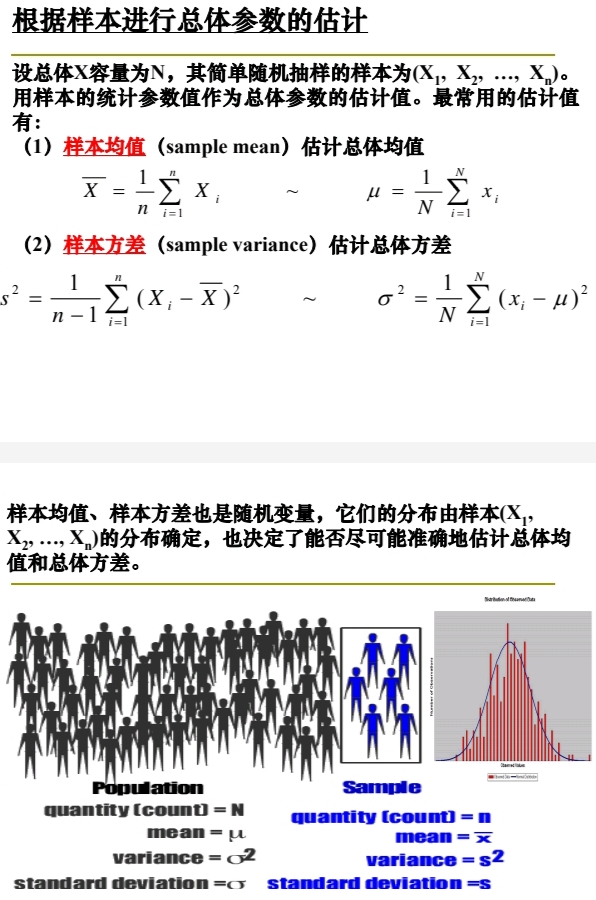
Example:
- \(\large X_{\theta_1} \sim {\mathcal {N}}(\mu_1 ,\sigma_1 ^{2})\)
- \(\large X_{\theta_2} \sim {\mathcal {N}}(\mu_2 ,\sigma_2 ^{2})\)
- parameter vector is \(\large \theta = [\mu, \sigma^{2}]\)
SciTech-Mathmatics-Probability+Statistics:Quantifing Uncertainty_统计数据分析:朱怀球PKU-3-Sampling Theory 统计抽样理论基础的更多相关文章
- 号外号外:9月21号关于Speed-BI 《全国人口统计数据分析》开讲了
引言:如何快速分析纷繁复杂的数据?如何快速做出老板满意的报表?如何快速将Speed-BI云平台运用到实际场景中? 本课程将通过各行各业案例背景,将Speed-BI云平台运用到实际场景中,通 ...
- 第十二章——SQLServer统计信息(2)——非索引键上统计信息的影响
原文:第十二章--SQLServer统计信息(2)--非索引键上统计信息的影响 前言: 索引对性能方面总是扮演着一个重要的角色,实际上,查询优化器首先检查谓词上的统计信息,然后才决定用什么索引.一般情 ...
- 从键盘输入一个字符串(长度不超过30),统计字符串中非数字的个数,并将统计的结果显示在屏幕上,用EXE格式实现。
问题 从键盘输入一个字符串(长度不超过30),统计字符串中非数字的个数,并将统计的结果显示在屏幕上,用EXE格式实现. 源程序 data segment hintinput db "plea ...
- Python数据分析之路(一)查询和统计
0. 如何入门数据分析 关注沙漠之鹰的同学一定看过沙漠君写得很多篇数据分析文章,比如分析房价,车价,预测机动车摇号这些话题.其实文章中所有的分析都使用了Python和它非常强大的数据分析库Pandas ...
- Apache Lens —— 统计数据分析查询接口
Lens 提供了一个统一数据分析接口.通过提供一个跨多个数据存储的单一视图来实现数据分析任务切分,同时优化了执行的环境.无缝的集成 Hadoop 实现类似传统数据仓库的功能. 该项目主要特性: 简单元 ...
- Probability&Statistics 概率论与数理统计(1)
基本概念 样本空间: 随机试验E的所有可能结果组成的集合, 为E的样本空间, 记为S 随机事件: E的样本空间S的子集为E的随机事件, 简称事件, 由一个样本点组成的单点集, 称为基本事件 对立事件/ ...
- HotApp小程序统计,第一个专业的微信第三方小程序统计工具
1.什么是HotApp小程序统计 HotApp小程序统计是第一个微信第三方小程序统计工具,就像做android 和 ios开发的人知道友盟统计一样,小程序也需要有个统计工具. 通过这个工具,可以知道小 ...
- B2C经典查询,统计 绝对用的上,根据日期分组统计当天各种支付方式的销售数量和销售额
declare @sql varchar(8000) set @sql = 'select CONVERT(varchar(10), OrderDate, 120) as 日期' select @sq ...
- 如何把百度统计代码放入JS文件中?百度统计的JS脚本原理分析
<script> var _hmt = _hmt || []; (function() { var hm = document.createElement("script&quo ...
- bash 统计在线时长最长的十个玩/统计一天内一直处于不活跃状态的玩家的百分比
1.某游戏的客户端每隔5分钟会向服务端报告一次玩家的账户积分,如果两次报告的时间间隔不大于5分钟,认为该玩家在这5分钟内在线,假设报告数据的格式如下: IP Dat ...
随机推荐
- python初学之random()模块
##python小脚本 random()是不能直接访问的,需要导入 random 模块,然后通过 random 静态对象调用该方法. random.random()用于生成 一个指定范围内的随机符点数 ...
- Linux操作系统(中)
上一篇分享了一些Linux操作系统最基本的一些命令和基础知识,下面,要分享的还是Linux操作系统的一些内容,因为在做网安这方面,Linux会经常用到而且也很重要,好了,废话不多说,要开始了. 在Li ...
- 关闭windows10 Alt+Tab开打edge选项卡
发现最近更新的windows10会使用快捷键Alt+Tab打开Edge的选项卡,很不适应,可喜的是微软提供了关闭的方法. 设置⚙->系统->多任务处理->Alt+Tab 设置为仅打开 ...
- 如何在 Linux 上检查开放的端口并关闭不需要的端口
检查服务器开放端口并关闭不必要的端口是网络安全管理中的关键环节,开放端口如同服务器的"窗口",若其中存在未被利用或未受保护的端口,就如同为潜在的攻击者敞开了大门,他们可能会利用这些 ...
- 传统的可扩展架构模式:分层架构和SOA
极客时间:<从 0 开始学架构>:传统的可扩展架构模式:分层架构和SOA 分层架构 分层架构是很常见的架构模式,它也叫 N 层架构,通常情况下,N 至少是 2 层.例如,C/S 架构.B/ ...
- 稀疏贝叶斯谱估计及EM算法求解
稀疏贝叶斯 稀疏贝叶斯学习(sparse bayes learning,SBL)最早被提出是作为一种机器学习算法[1].但是在这里我们主要用它来做谱估计,作为求解稀疏重构问题的方法[2].稀疏重构还有 ...
- 注解@Transactional事务失效的常见场景
在<Spring Boot事务管理>中,小编介绍了注解@Transactional的基本属性和使用方法,这里介绍事务失效的八种场景,使大家对注解@Transactional有一个更深刻的认 ...
- 洛谷 P5590 赛车游戏
洛谷 P5590 赛车游戏 P5590 赛车游戏 Problem 给一张有向图,请给每一条边赋上边权\(w\in[1,9]\)使得每一条\(1\to n\)的路径的长度相等. Solution 先来点 ...
- 洛谷 SP7258 SUBLEX - Lexicographical Substring Search
洛谷 SP7258 SUBLEX - Lexicographical Substring Search Problem 先给你一个字符串s,后有T次询问.询问这个字符串的所有本质不同的子串中第k小的子 ...
- Flex布局,绝对定位,层叠布局Stack的详细讲解
Flex布局 Flex布局也叫做:伸缩布局,当子盒子的总和溢出父盒子时默认进行压缩显示 线性布局的原理是基于Flex来设计的. Flex布局默认主轴是:水平向右的,交叉轴垂:直向下 单行或者单列的情况 ...
